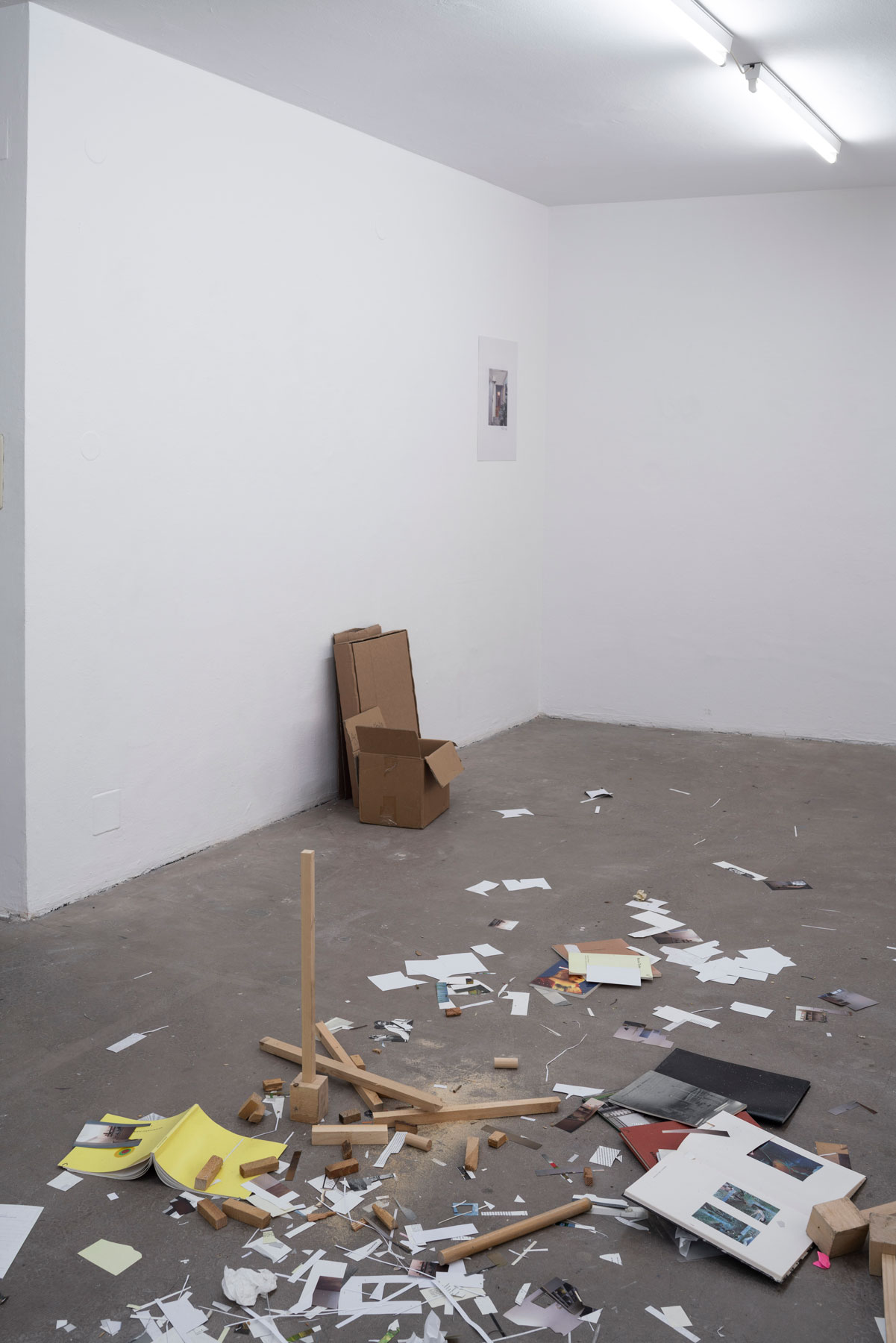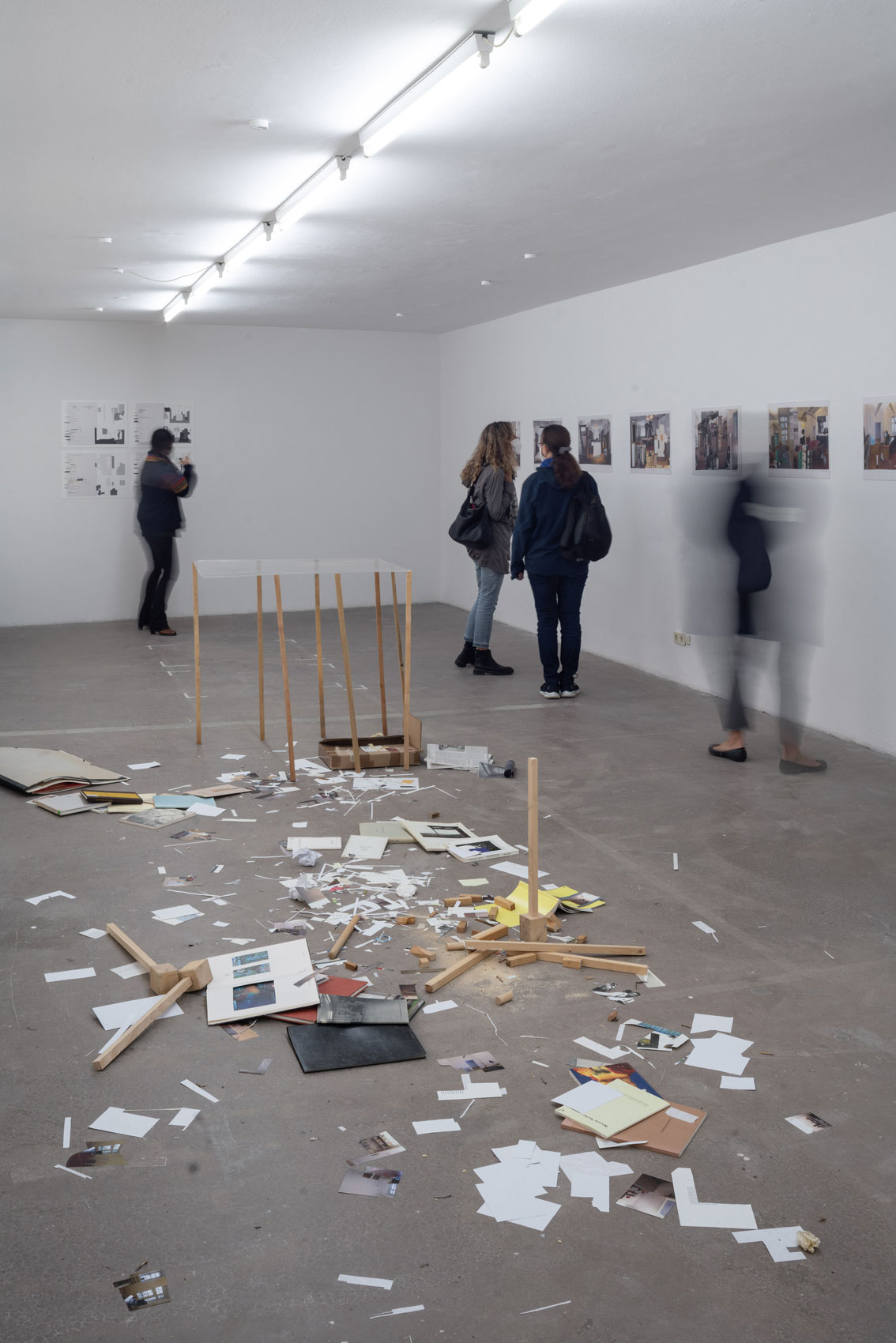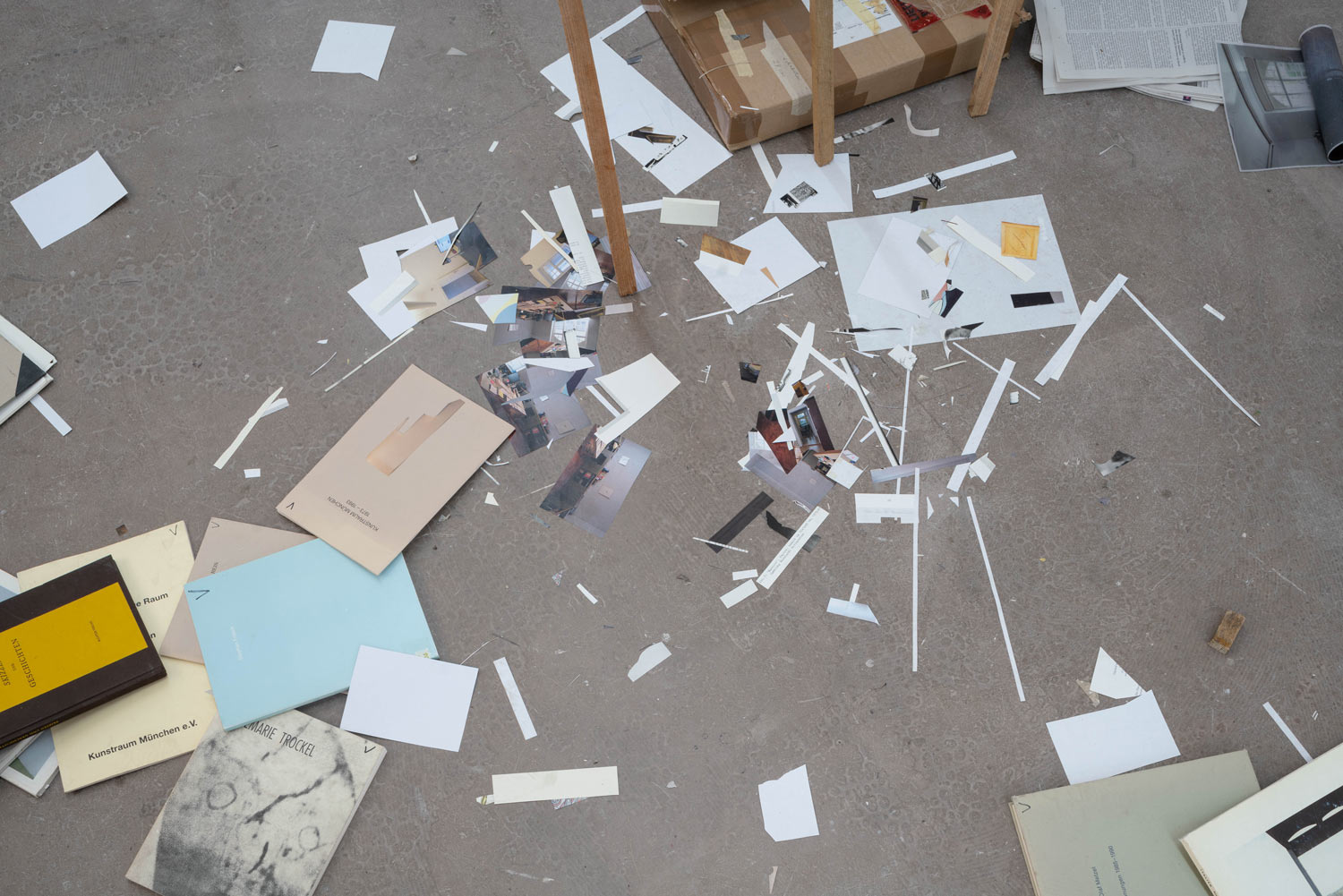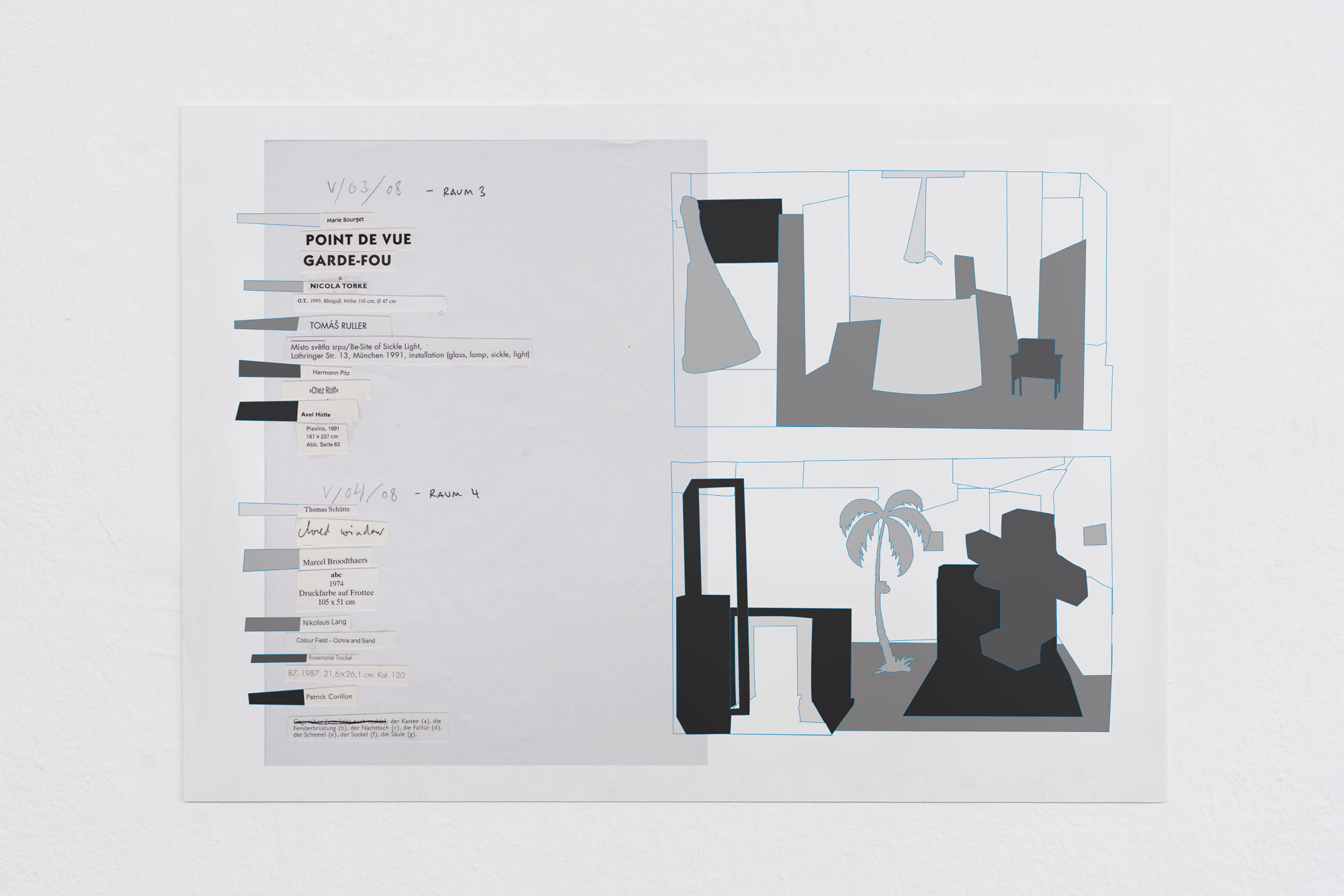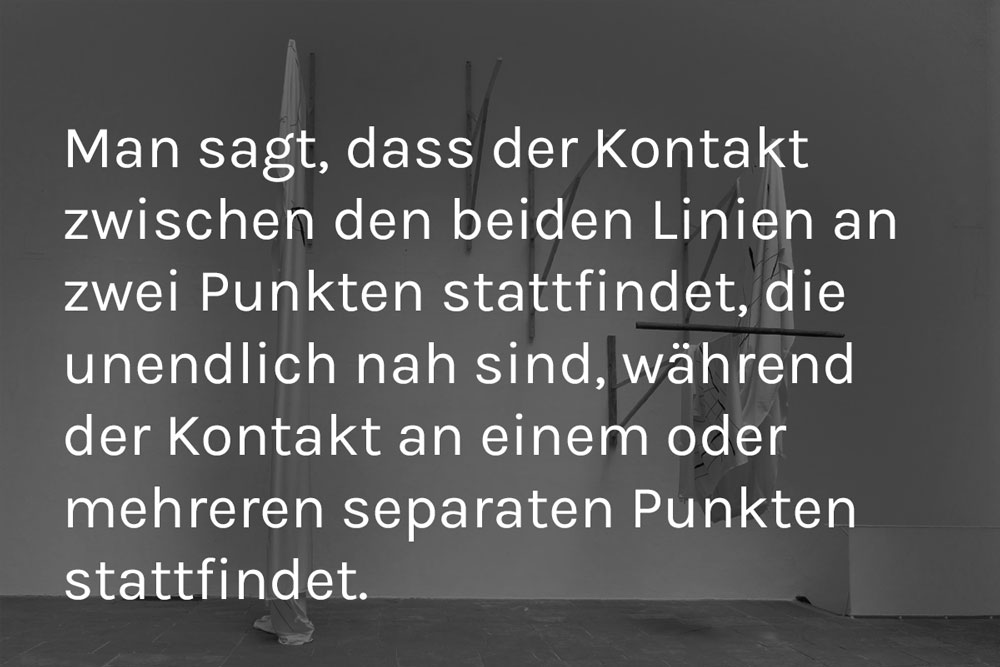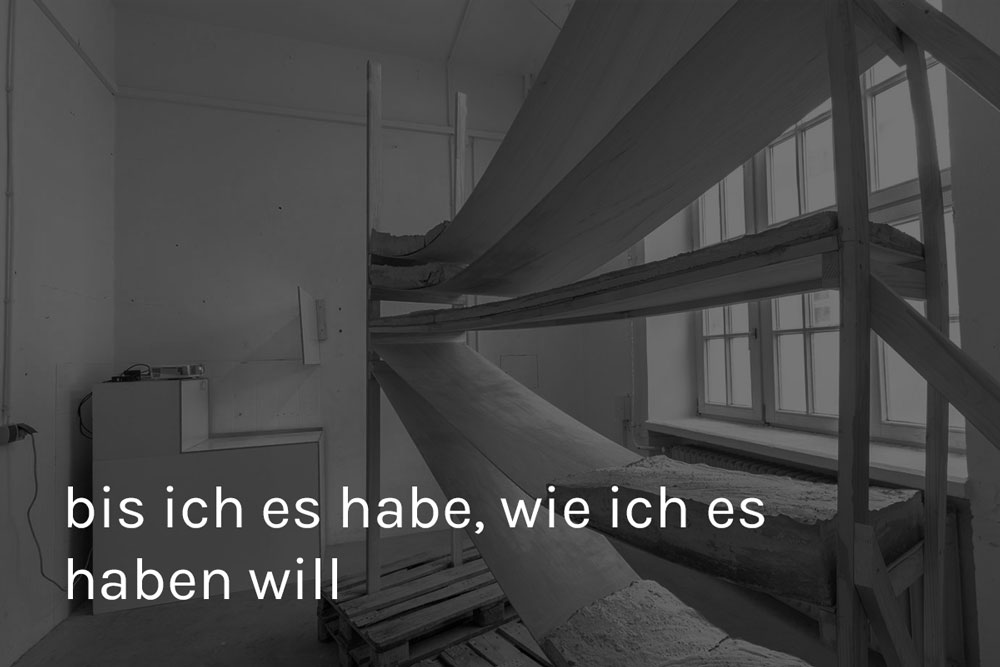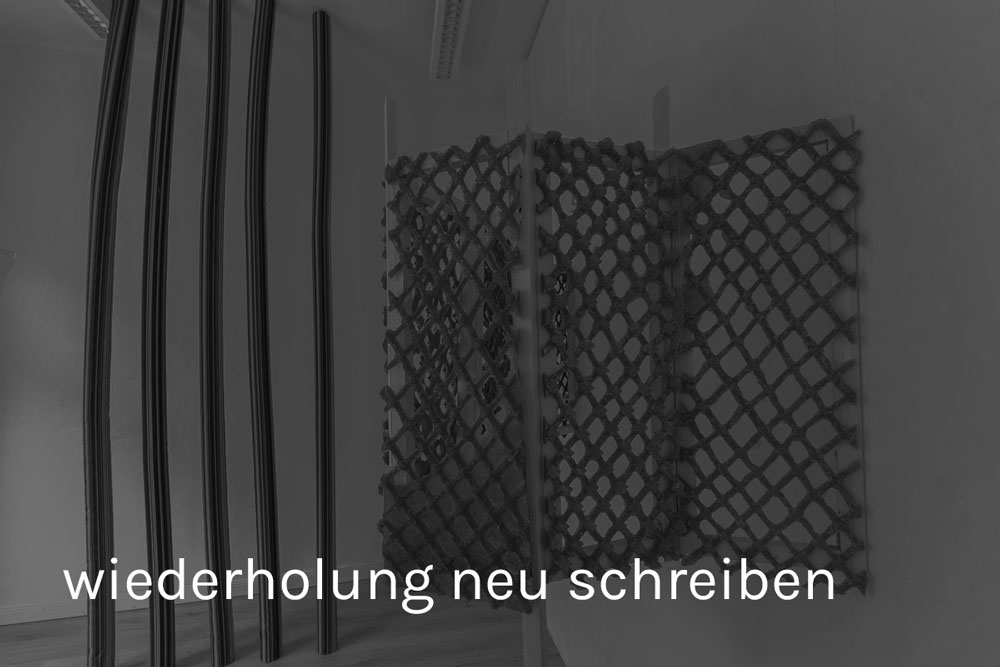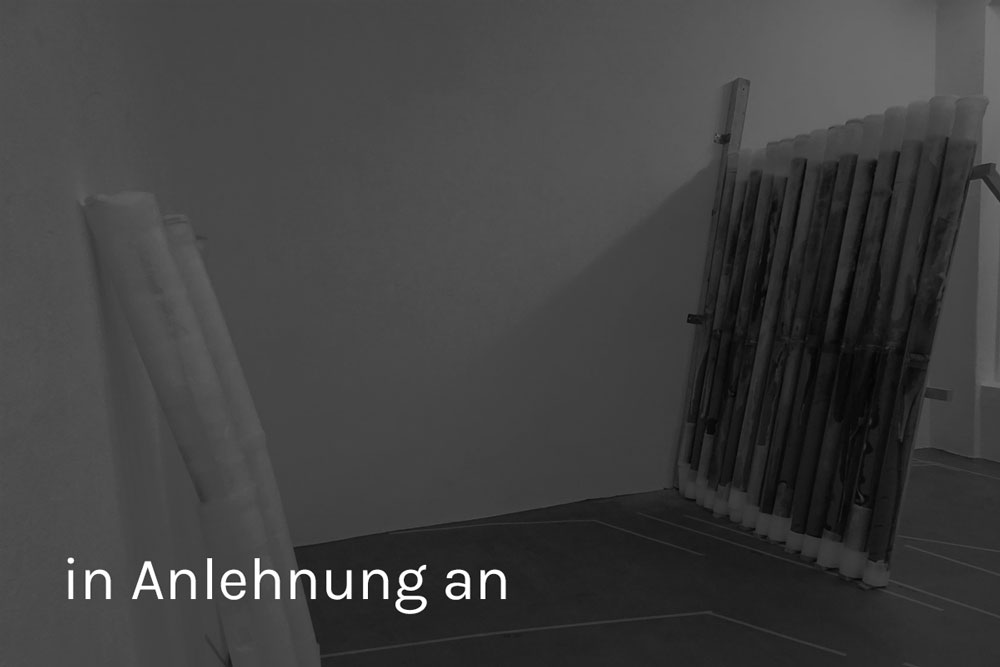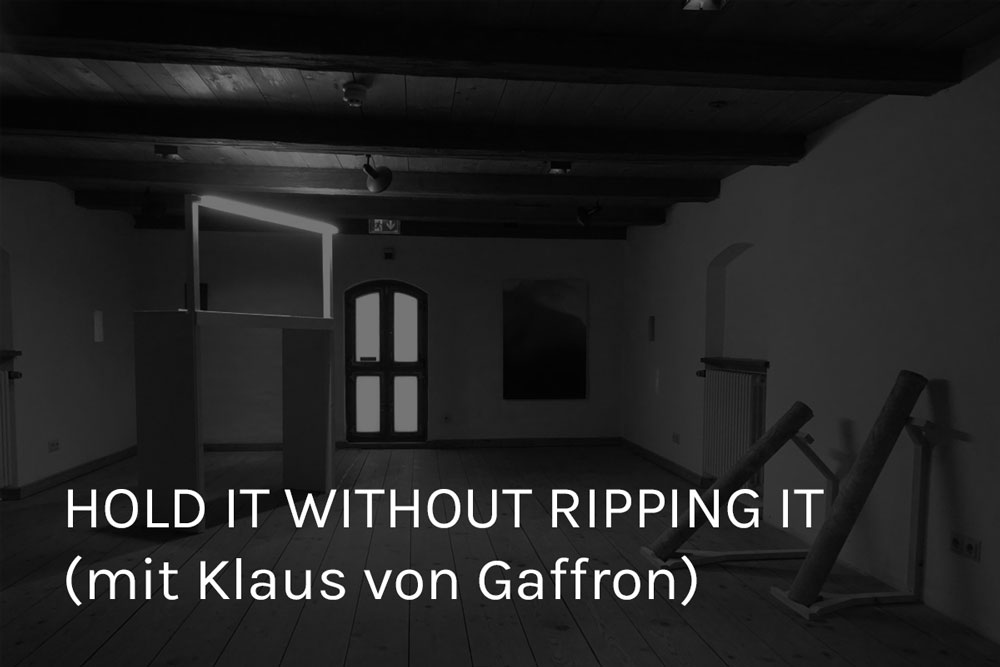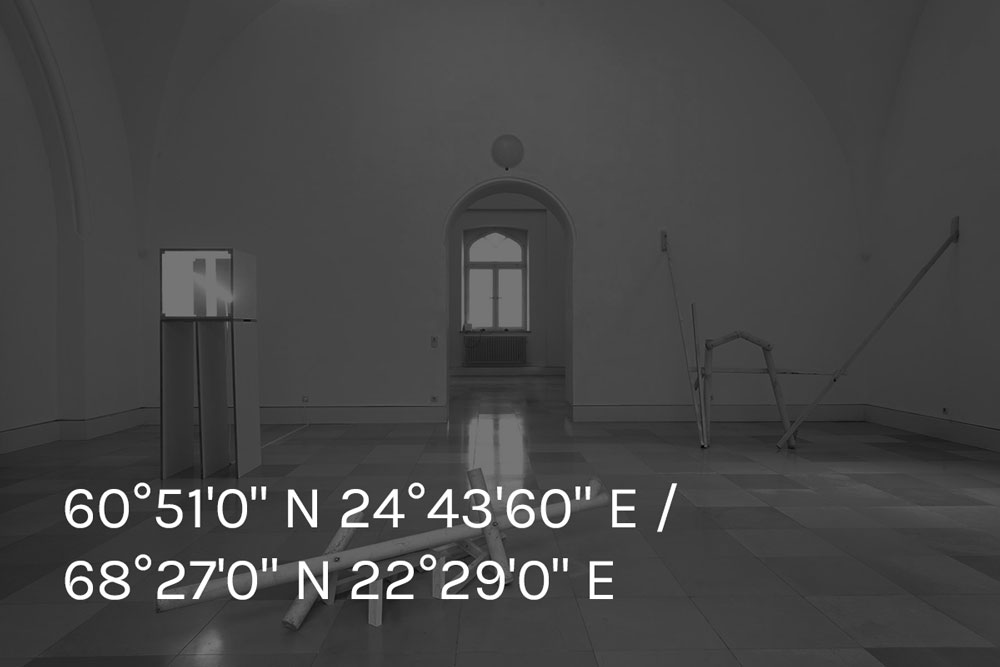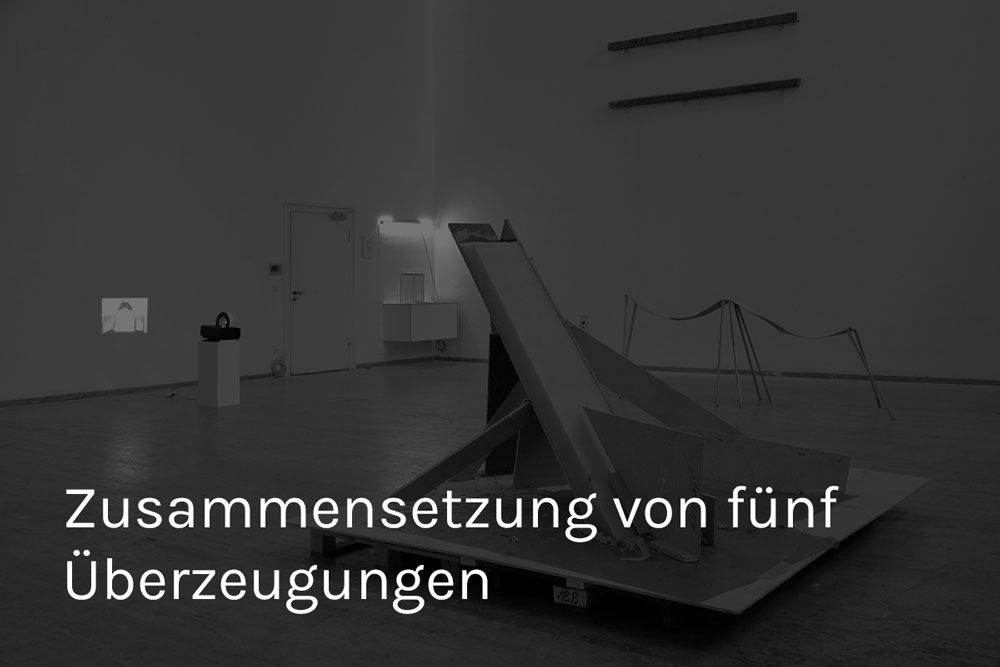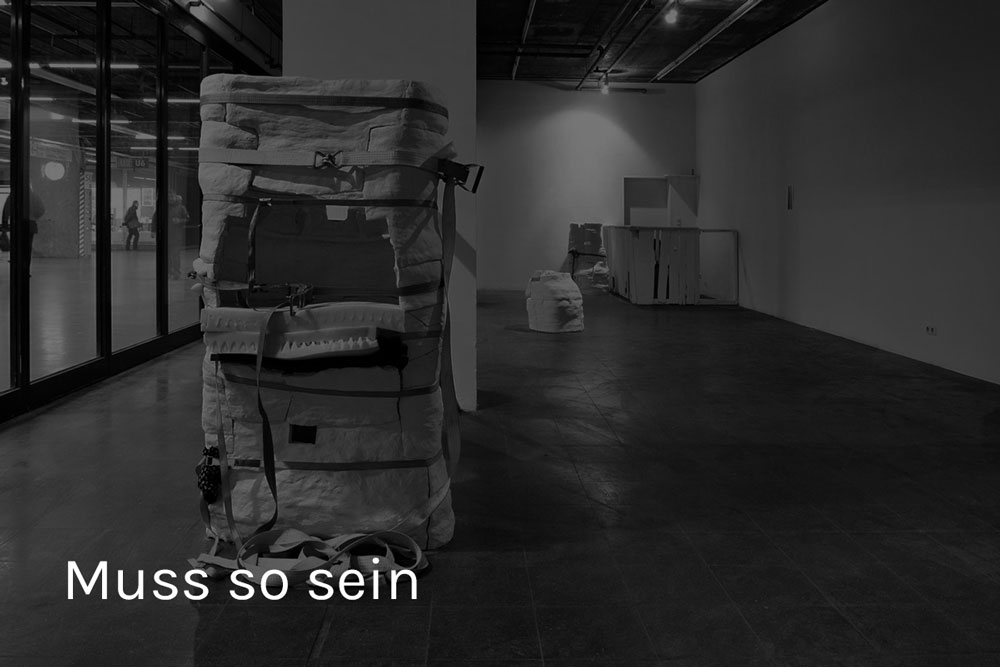Viktor-Scheffel-Str. 20
Kunstraum München, 2021, Ausstellung im Rahmen der Sommerresidenz 2021
Kunstraum München, Munich 2021, exhibition as part of summer residence 2021
Installation
Drucke auf Hartschaumplatten, Plexiglas, Holz, Bücher, Papier, Karton
Installation
Prints on rigid foam board, Plexiglas, wood, books, paper, cardboard boxes
Fotos/photographs: Lennart Kraus
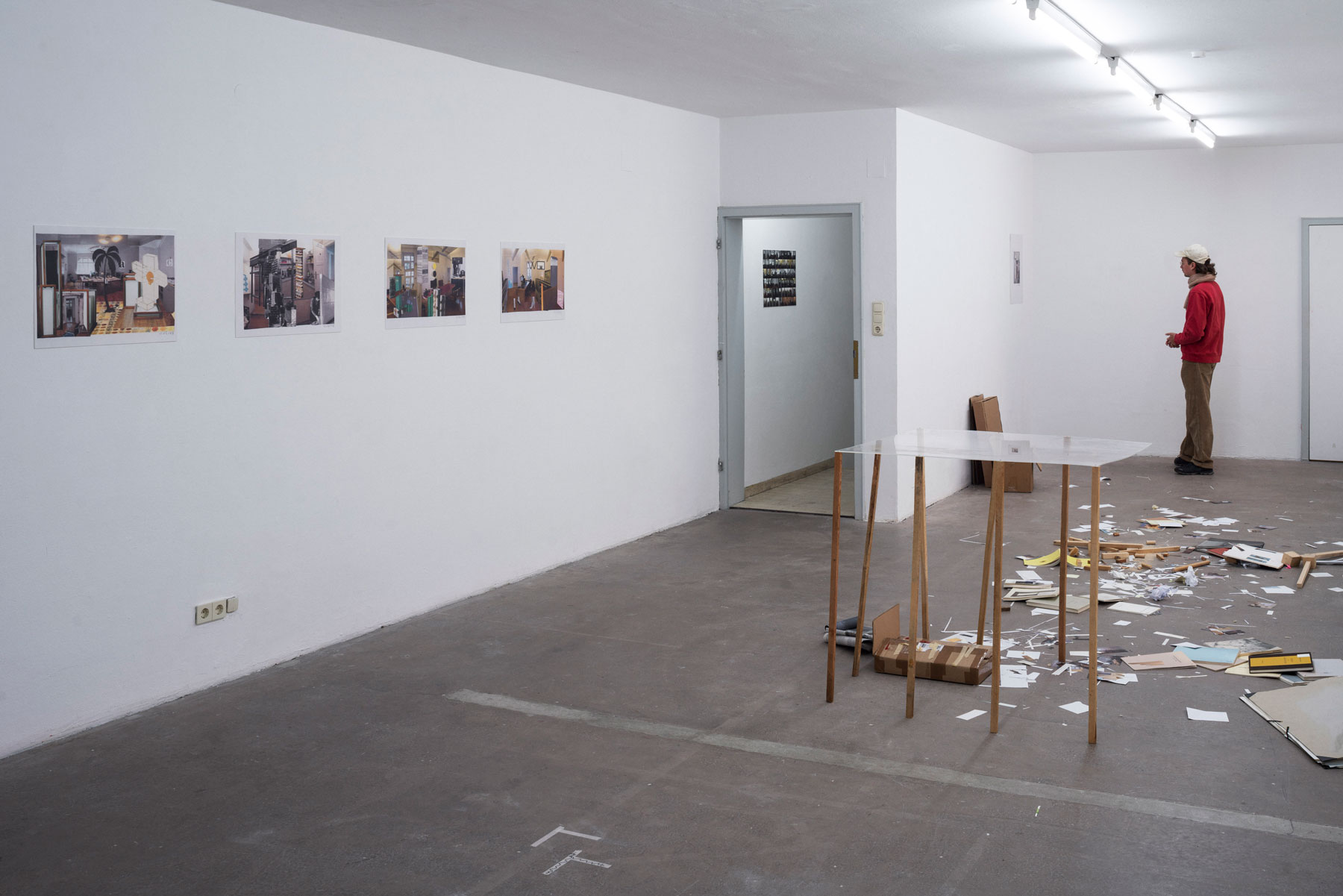
Im Sommer 2021 war Paula Leal Olloqui zur Sommerresidenz im Kunstraum München eingeladen. In der Zeit, in der ihr die Ausstellungsräume des Kunstraum als Atelier und Arbeitsraum zur Verfügung standen, begann die Künstlerin mit der Arbeit an einem publizitischen Format, das ihre räumliche, ortsbezogene künstlerische Auseinandersetzung und Arbeitsweise auf den Kontext der Geschichte des Kunstraums ausdehnt.
Dieser hat in seiner fast 50-jährigen Geschichte viele unterschiedliche Räume als Ausstellungsorte genutzt. Paula Leal Olloqui hat diese Räume in ihrem jetzigen Zustand wieder aufgesucht und fotografiert; und ist dabei zum Beispiel auf eine spanisch-deutsche Kinderkrippe oder eine Anwaltskanzlei gestoßen. Die Kataloge, die der Kunstraum München zu jeder Ausstellung publizierte, dienen ihr neben den Fotos der alten Räumlichkeiten in ihrem jetzigen Zustand, als Material für ihre Collagen, in denen sie die Arbeiten der Künstler die damals dort ausgestellt haben wieder im gleichen Raum platziert - im Fall der Viktor-Scheffel-Str. 20 in einer Anwaltskanzlei.
Die Viktor-Scheffel-Str. 20 bildet den Anfang eines Rechercheprojektes, das sich auch mit den anderen vom Kunstraum München genutzten Orten auseinandersetzen wird und in Kooperation mit dem Grafiker Niklas Hlawitschka entsteht. Eine erste Präsentation fand als Abschluss der Sommerresidenz im Kunstraum München statt. In der hier gezeigten installativen Raumbespielung finden sich diverse Bezüge zum Arbeitsprozess, der sich in den vorangegangenen Wochen im selben Raum abgespielt hatte. Zahlreiche zerschnittene Kataloge, Papierfetzen, Mappen, Kleberrückstände und Tape, Sägespäne und Holzreste verweisen auf die Arbeitssituation. Ein fragiles Gebilde erinnert an einen Tisch, nutzbar als solcher ist es nicht. Der Verweis auf die Ateliernutzung wirkt präsent und zeitgleich entrückt. An der Wand lehnen Kartons als warteten sie darauf, dass jemand kommt, zusammenpackt, um an einem anderen Ort weiter zu arbeiten.
(Text: Niklas Hlawitschka, 2021)
Die Viktor-Scheffel-Str. 20 bildet den Anfang eines Rechercheprojektes, das sich auch mit den anderen vom Kunstraum München genutzten Orten auseinandersetzen wird und in Kooperation mit dem Grafiker Niklas Hlawitschka entsteht. Eine erste Präsentation fand als Abschluss der Sommerresidenz im Kunstraum München statt. In der hier gezeigten installativen Raumbespielung finden sich diverse Bezüge zum Arbeitsprozess, der sich in den vorangegangenen Wochen im selben Raum abgespielt hatte. Zahlreiche zerschnittene Kataloge, Papierfetzen, Mappen, Kleberrückstände und Tape, Sägespäne und Holzreste verweisen auf die Arbeitssituation. Ein fragiles Gebilde erinnert an einen Tisch, nutzbar als solcher ist es nicht. Der Verweis auf die Ateliernutzung wirkt präsent und zeitgleich entrückt. An der Wand lehnen Kartons als warteten sie darauf, dass jemand kommt, zusammenpackt, um an einem anderen Ort weiter zu arbeiten.
(Text: Niklas Hlawitschka, 2021)
In the summer of 2021, Paula Leal Olloqui was invited to the summer residency at Kunstraum München. During the time that the Kunstraum's exhibition spaces were available to her as a studio and working space, the artist began working on a publication format that extends her spatial, site-specific artistic exploration and working method to the context of the Kunstraum's history.
Kunstraum has used many different spaces as exhibition venues in its almost 50-year history. Paula Leal Olloqui has revisited and photographed these spaces in their present state; and in doing so has come across, for example, a Spanish-German kindergarten or a lawyer's office. The catalogues that Kunstraum München published for each exhibition serve her, alongside the photos of the old spaces in their present state, as material for her collages, in which she places the works of the artists, who exhibited there at the time, back in the same space - in the case of Viktor-Scheffel-Str. 20 in a lawyer's office.
Viktor-Scheffel-Str. 20 marks the beginning of a research project that will also deal with the other locations used by Kunstraum München and which is being developed in cooperation with graphic artist Niklas Hlawitschka. A first presentation took place as the final exhibition of the summer residency at Kunstraum München. In the installation shown here, various references can be found to the work process that had taken place in the same space during the previous weeks. Numerous cut-up catalogues, scraps of paper, folders, glue residues and tape, sawdust and wood remnants refer to the working situation. A fragile structure is reminiscent of a table, but it cannot be used as such. The reference to the use of the room as a working space seems present and at the same time distant. Cardboard boxes lean against the wall as if waiting for someone to come and pack up to continue working in another place.
(Text: Niklas Hlawitschka, 2021)
Kunstraum has used many different spaces as exhibition venues in its almost 50-year history. Paula Leal Olloqui has revisited and photographed these spaces in their present state; and in doing so has come across, for example, a Spanish-German kindergarten or a lawyer's office. The catalogues that Kunstraum München published for each exhibition serve her, alongside the photos of the old spaces in their present state, as material for her collages, in which she places the works of the artists, who exhibited there at the time, back in the same space - in the case of Viktor-Scheffel-Str. 20 in a lawyer's office.
Viktor-Scheffel-Str. 20 marks the beginning of a research project that will also deal with the other locations used by Kunstraum München and which is being developed in cooperation with graphic artist Niklas Hlawitschka. A first presentation took place as the final exhibition of the summer residency at Kunstraum München. In the installation shown here, various references can be found to the work process that had taken place in the same space during the previous weeks. Numerous cut-up catalogues, scraps of paper, folders, glue residues and tape, sawdust and wood remnants refer to the working situation. A fragile structure is reminiscent of a table, but it cannot be used as such. The reference to the use of the room as a working space seems present and at the same time distant. Cardboard boxes lean against the wall as if waiting for someone to come and pack up to continue working in another place.
(Text: Niklas Hlawitschka, 2021)
